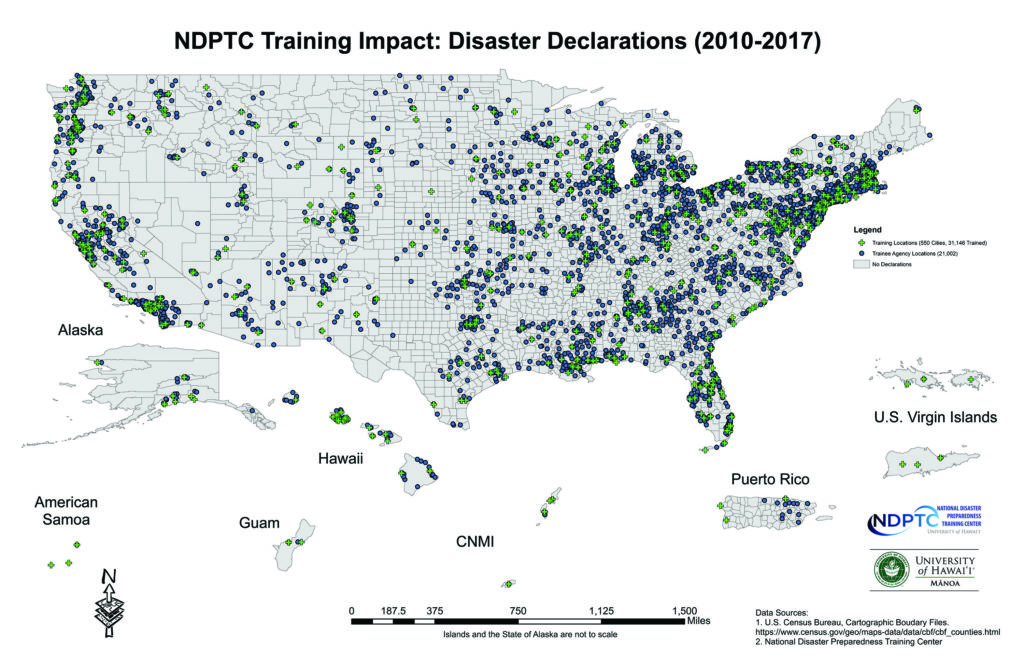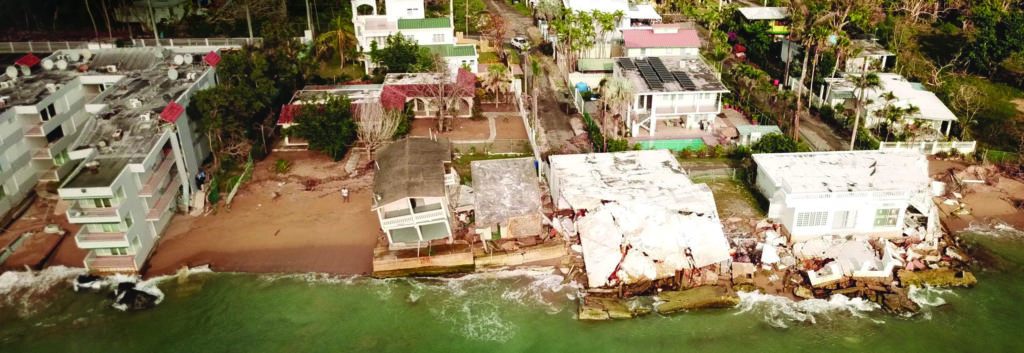Putting Science Into Action
To many individuals around the world, 2017 may have seemed like the apocalypse or at least something close to it in terms of damage from natural disasters. The 2017 U.S. hurricane season has been the most expensive ever. In late August, Hurricane Harvey hit Texas, setting rainfall records with extensive flooding in Houston. In early September, Hurricane Irma struck the U.S. Virgin Islands, devastated the Florida Keys and threatened Tampa and its surrounding areas. Just as Irma dissipated, Hurricane Maria hit Puerto Rico causing major damage to power, water, communications and other infrastructure. Many homes and businesses were destroyed with significant with economic losses exceeding $90 billion. In 2017 wildfires burned more than 9.8 million acres, with costs approaching $18 billion.
The National Disaster Preparedness Training Center (NDPTC), a research and training center in the Department of Urban and Regional Planning at the University of Hawai‘i at Mānoa’s College of Social Sciences, is responding to this global need for natural disaster research, education and training. Funded by the U.S. Department of Homeland Security (DHS) and the Federal Emergency Management Agency (FEMA), NDPTC uses a “whole community” approach to disaster risk reduction and works to help communities prepare for, respond to and recover from disasters.
“Disasters are teachable moments,” said Karl Kim, professor of Urban and Regional Planning and the NDPTC executive director. “They magnify what works and what doesn’t work in a society or a community.”
Kim and his team of disaster management experts at NDPTC develop and deliver training courses for first responders, emergency managers and the community. This includes the development of FEMA’s first social media class which focuses on both pushing vital information out to communities from emergency management agencies and using various social media tools for detecting and “crowdsourcing” vital information from communities.
The NDPTC team has also developed and delivered courses on hazards such as volcanoes, hurricanes, coastal flooding, and severe weather, including FEMA’s first certified course on tsunamis with the National Oceanic and Atmospheric Administration and the International Tsunami Information Center. The NDPTC has also partnered with local engineering, planning and design firms to develop courses on drones, geospatial analysis, disaster communications and rapid damage assessment.
Since 2009, NDPTC has received approximately $5 million annually, totaling more than $45 million, to continue development and delivery of courses that support real-time evaluation of vulnerabilities and risks, rapid damage assessment, as well as urban planning and environmental management to address the most serious threats facing Hawai‘i as well as other coastal communities. The NDPTC is one of seven members of the National Domestic Preparedness Consortium, a professional alliance sponsored DHS and the FEMA National Preparedness Directorate. In addition to the University of Hawai‘i, the consortium includes three other universities (Louisiana State University, Texas A&M, and New Mexico Tech), as well as the Center for Domestic Preparedness, the Nevada Test Site, and the Transportation Technology Center, Inc.

To-date, NDPTC has trained more than 35,000 first responders and emergency managers and others involved in disaster response and recovery in more than 300 cities, villages and rural communities across the United States, and in its flag and trust territories. The ultimate goal of the NDPTC is to build stronger communities.
“By looking at the impacts of disasters on communities and households, how we respond to it, how we recover from it and how we rebuild communities affected by these disasters, we can reduce the number of people that are killed or injured, lose their homes or have their lives disrupted,” said Kim. “I’m confident that though the integration of scientific knowledge, risk management and effective policies and plans—we as a university can play a vital role to help increase community safety and security.”

